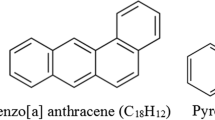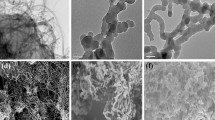Abstract
An electrochemical sensor based on molecularly imprinted polypyrrole membranes is reported for the determination of 2,4-dichlorophenoxy acetic acid (2,4-D). The sensor was prepared by electropolymerization of pyrrole on a glassy carbon electrode in the presence of 2,4-D as a template. The template was removed by overoxidation at +1.3 V in buffer solution. The sensor can effectively improve the reductive properties of 2,4-D and eliminate interferences by other pesticides and electroactive species. The peak current at -0.78 V is linear with the concentration of 2,4-D from 1.0 to 10 µM, the detection limit is 0.83 µM (at 3σ), and the relative standard deviation is 3.9% (at 5.0 µM of 2,4-D; n = 7). The method has been successfully applied to the determination of 2,4-D in environmental water samples, with recovery rates ranging from 92% to 108%.






Similar content being viewed by others
References
Wu JM, Ee KH, Lee HK (2005) Automated dynamic liquid–liquid–liquid microextraction followed by high-performance liquid chromatography-ultraviolet detection for the determination of phenoxy acid herbicides in environmental waters. J Chromatogr A 1082:121–127
Zhu LY, Lee HK (2001) Field-amplified sample injection combined with water removal by electroosmotic flow pump in acidic buffer for analysis of phenoxy acid herbicides by capillary electrophoresis. Anal Chem 73:3065–3072
Shin HS (2006) Determination of phenoxy acid pesticides in frog and fish tissues by gas chromatography-mass spectrometry. Chromatographia 63:579–583
Kim GY, Shim J, Kang MS, Moon SH (2008) Preparation of a highly sensitive enzyme electrode using gold nanoparticles for measurement of pesticides at the ppt level. J Environ Monit 10:632–637
Deng AP, Yang H (2007) A multichannel electrochemical detector coupled with an ELISA microtiter plate for the immunoassay of 2, 4-dichlorophenoxyacetic acid. Sens Actuators B: Chem 124:202–208
Navrátilová I, Skládal P (2004) The immunosensors for measurement of 2, 4-dichlorophenoxyacetic acid based on electrochemical impedance spectroscopy. Bioelectrochemistry 62:11–18
Gobi KV, Kim SJ, Tanaka H, Shoyama Y, Miura N (2007) Novel surface plasmon resonance (SPR) immunosensor based on monomolecular layer of physically-adsorbed ovalbumin conjugate for detection of 2, 4-dichlorophenoxyacetic acid and atomic force microscopy study. Sens Actuators B: Chem 123:583–593
Kim SJ, Gobi KV, Tanaka H, Shoyama Y, Miura N (2008) A simple and versatile self-assembled monolayer based surface plasmon resonance immunosensor for highly sensitive detection of 2, 4-D from natural water resources. Sens Actuators B: Chem 130:281–289
Gobi KV, Tanaka H, Shoyama Y, Miura N (2005) Highly sensitive regenerable immunosensor for label-free detection of 2, 4-dichlorophenoxyacetic acid at ppb levels by using surface plasmon resonance imaging. Sens Actuators B: Chem 111(112):562–571
Mosiello L, Nencini L, Segre L, Spanò M (1997) A fibre-optic immunosensor for 2, 4-dichlorophenoxyacetic acid detection. Sens Actuators B: Chem 39:353–359
Long F, Shi HC, He M, Zhu AN (2008) Sensitive and rapid detection of 2, 4-dicholorophenoxyacetic acid in water samples by using evanescent wave all-fiber immunosensor. Biosens Bioelectron 23:1361–1366
Haupt K, Mosbach K (2000) Molecularly imprinted polymers and their use in biomimetic sensors. Chem Rev 100:2495–2504
Wulff G (2002) Enzyme-like catalysis by molecularly imprinted polymers. Chem Rev 102:1–28
Xie CG, Zhang ZP, Wang DP, Guan GJ, Gao DM, Liu JH (2006) Surface molecular self-assembly strategy for TNT imprinting of polymer nanowire/nanotube arrays. Anal Chem 78:8339–8346
Xie CG, Liu BH, Wang ZY, Gao DM, Guan GJ, Zhang ZP (2008) Molecular imprinting at walls of silica nanotubes for TNT recognition. Anal Chem 80:437–443
Gao DM, Zhang ZP, Wu MH, Xie CG, Guan GJ, Wang DP (2007) A surface functional monomer-directing strategy for highly dense imprinting of TNT at surface of silica nanoparticles. J Am Chem Soc 129:7859–7866
Yang M, Chen YT, Ma J, Huai LF (2009) Differential pulse voltammetric determination of trace rotenone using molecularly imprinted polymer microspheres. Microchim Acta 166:95–99
Jin GY, Tang YW (2009) Evaluation of a novel silica-supported sol–gel sorbent prepared by a surface molecular imprinting technique for the selective separation of estazolam from human plasma. Microchim Acta 165:143–149
Malitesta C, Losito I, Zambonin PG (1999) Molecularly imprinted electrosynthesized polymers: new materials for biomimetic sensors. Anal Chem 71:1366–1370
Liu XY, Li CY, Wang CF, Li T, Hu SH (2006) The preparation of molecularly imprinted poly(ophenylenediamine) membranes for the specific O, O-dimethyl-α-hydroxylphenyl phosphonate sensor and its characterization by AC impedance and cyclic voltammetry. J Appl Polym Sci 101:2222–2227
Özcan L, Şahin Y (2007) Determination of paracetamol based on electropolymerized-molecularly imprinted polypyrrole modified pencil graphite electrode. Sens Actuators B: Chem 127:362–369
Ramanavičius A, Ramanavičienė A, Malinauskasc A (2006) Electrochemical sensors based on conducting polymer-polypyrrole. Electrochim Acta 51:6025–6037
Shiigi H, Yakabe H, Kishimoto M, Kijima D, Zhang Y, Sree U, Deore BA, Nagaoka T (2003) Molecularly Imprinted overoxidized polypyrrole colloids: promising materials for molecular recognition. Microchim Acta 143:155–162
Deore B, Chen ZD, Nagaoka T (2000) Potential-induced enantioselective uptake of amino acid into molecularly imprinted overoxidized polypyrrole. Anal Chem 72:3989–3994
Okuno H, Kitano T, Yakabe H, Kishimoto M, Deore BA, Siigi H, Nagaoka T (2002) Characterization of overoxidized polypyrrole colloids imprinted with L-lactate and their application to enantioseparation of amino acids. Anal Chem 74:4184–4190
Özkorucuklu SP, Şahin Y, Alsancak G (2008) Voltammetric behaviour of sulfamethoxazole on electropolymerized-molecularly imprinted overoxidized polypyrrole. Sensors 8:8463–8478
Xie CG, Li HF, Xie CY, Zhou HK (2009) Preparation of electrochemical salicylic acid sensor based on molecular imprinted film. Chinese J Anal Chem 37:1045–1048
Feng JT, Wei Yan W, Zhang LZ (2009) Synthesis of polypyrrole micro/nanofibers via a self-assembly process. Microchim Acta 166:261–267
Xie CG, Li HF, Li SQ, Wu J, Zhang ZP (2010) Surface molecular self-assembly for organophosphate pesticide imprinting in electropolymerized poly(p-aminothiophenol) membranes on a gold nanoparticle modified glassy carbon electrode. Anal Chem 82:241–249
Blanco-López MC, Lobo-Castañón MJ, Miranda-Ordiers AJ, Tuñón-Blanco P (2004) Electrochemical sensors based on molecularly imprinted polymers. Trends in Anal Chem 23:36–48
Solanki PR, Prabhakar N, Pandey MK, Malhotra BD (2008) Self-assembled monolayer for toxicant detection using nucleic acid sensor based on surface plasmon resonance technique. Biomed Mircrodevies 10:757–767
Li JP, Zhao J, Wei XP (2009) A sensitive and selective sensor for dopamine determination based on a molecularly imprinted electropolymer of o-aminophenol. Sens Actuators B: Chem 140:663–669
Lu LP, Wang SQ, Lin XQ (2004) Fabrication of layer-by-layer deposited multilayer films containing DNA and gold nanoparticles for norepinephrine biosensor. Anal Chim Acta 519:161–166
Jie GF, Liu B, Pan HC, Zhu JJ, Chen HY (2007) CdS nanocrystal-based electrochemiluminescence biosensor for the detection of low-density lipoprotein by increasing sensitivity with gold nanoparticle amplification. Anal Chem 79:5574–5581
Liu Y, Yu YY, Yang QY, Qu YH, Liu YM, Shi GY, Jin LT (2008) Trace detection of nitroaromatic compounds with layer-by-layer assembled {SBA/PSS}n/PDDA modified electrode. Sens Actuators B: Chem 131:432–438
Schöllhorn B, Maurice C, Flohic G, Limoges B (2000) Competitive assay of 2, 4-dichlorophenoxyacetic acid using a polymer imprinted with an electrochemically active tracer closely related to the analyte. Analyst 125:665–667
Weetall HH, Hatchett DW, Rogers KR (2005) Electrochemically deposited polymer-coated gold electrodes selective for 2, 4-dichlorophenoxyacetic Acid. Electroanal 17:1789–1794
Liu GD, Lin YH (2005) Electrochemical sensor for organophosphate pesticides and nerve agents using zirconia nanoparticles as selective sorbents. Anal Chem 77:5894–5901
Acknowledgment
This work was supported by the National Natural Science Foundation of China (No. 20875070).
Author information
Authors and Affiliations
Corresponding author
Rights and permissions
About this article
Cite this article
Xie, C., Gao, S., Guo, Q. et al. Electrochemical sensor for 2,4-dichlorophenoxy acetic acid using molecularly imprinted polypyrrole membrane as recognition element. Microchim Acta 169, 145–152 (2010). https://doi.org/10.1007/s00604-010-0303-7
Received:
Accepted:
Published:
Issue Date:
DOI: https://doi.org/10.1007/s00604-010-0303-7




